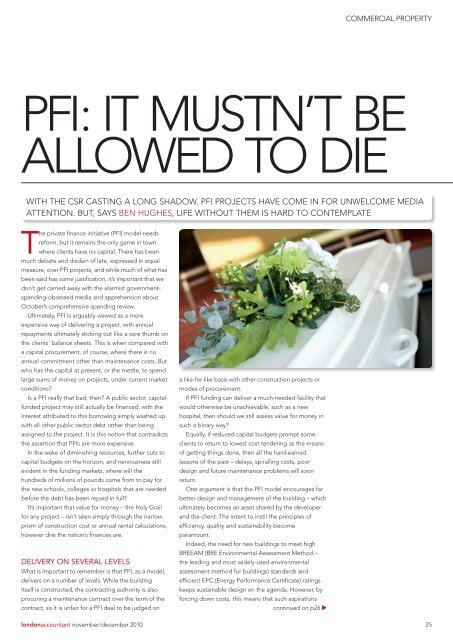londonaccountant - ICAEW
londonaccountant - ICAEW
londonaccountant - ICAEW
- No tags were found...
You also want an ePaper? Increase the reach of your titles
YUMPU automatically turns print PDFs into web optimized ePapers that Google loves.
COMMERCIAL PROPERTYPFI: IT MUSTN’T BEALLOWED TO DIEWITH THE CSR CASTING A LONG SHADOW, PFI PROJECTS HAVE COME IN FOR UNWELCOME MEDIAATTENTION. BUT, SAYS BEN HUGHES, LIFE WITHOUT THEM IS HARD TO CONTEMPLATEThe private finance initiative (PFI) model needsreform, but it remains the only game in townwhere clients have no capital. There has beenmuch debate and disdain of late, expressed in equalmeasure, over PFI projects, and while much of what hasbeen said has some justification, it’s important that wedon’t get carried away with the alarmist governmentspending-obsessedmedia and apprehension aboutOctober’s comprehensive spending review.Ultimately, PFI is arguably viewed as a moreexpensive way of delivering a project, with annualrepayments ultimately sticking out like a sore thumb onthe clients’ balance sheets. This is when compared witha capital procurement, of course, where there is noannual commitment other than maintenance costs. Butwho has the capital at present, or the mettle, to spendlarge sums of money on projects, under current marketconditions?Is a PFI really that bad, then? A public sector, capitalfundedproject may still actually be financed, with theinterest attributed to this borrowing simply washed upwith all other public sector debt rather than beingassigned to the project. It is this notion that contradictsthe assertion that PFIs are more expensive.In the wake of diminishing resources, further cuts tocapital budgets on the horizon, and nervousness stillevident in the funding markets, where will thehundreds of millions of pounds come from to pay forthe new schools, colleges or hospitals that are neededbefore the debt has been repaid in full?It’s important that value for money – the Holy Grailfor any project – isn’t seen simply through the narrowprism of construction cost or annual rental calculations,however dire the nation’s finances are.DELIVERY ON SEVERAL LEVELSWhat is important to remember is that PFI, as a model,delivers on a number of levels. While the buildingitself is constructed, the contracting authority is alsoprocuring a maintenance contract over the term of thecontract, so it is unfair for a PFI deal to be judged ona like-for-like basis with other construction projects ormodes of procurement.If PFI funding can deliver a much-needed facility thatwould otherwise be unachievable, such as a newhospital, then should we still assess value for money insuch a binary way?Equally, if reduced capital budgets prompt someclients to return to lowest cost tendering as the meansof getting things done, then all the hard-earnedlessons of the past – delays, spiralling costs, poordesign and future maintenance problems will soonreturn.One argument is that the PFI model encourages farbetter design and management of the building – whichultimately becomes an asset shared by the developerand the client. The intent to instil the principles ofefficiency, quality and sustainability becomeparamount.Indeed, the need for new buildings to meet highBREEAM (BRE Environmental Assessment Method –the leading and most widely-used environmentalassessment method for buildings) standards andefficient EPC (Energy Performance Certificate) ratingskeeps sustainable design on the agenda. However, byforcing down costs, this means that such aspirationscontinued on p26 <strong>londonaccountant</strong> november/december 201025
















